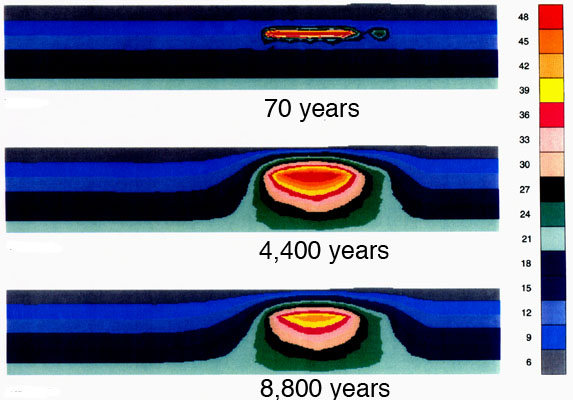Do Radioactive Wastes Produce Heat?
A background piece by Gordon Edwards, July 12, 2011
Once radioactive materials have been created, nobody
knows how to shut off the radioactivity. Radioactivity is
caused by the spontaneous disintegration of unstable
atoms; in fact the unit of radioactivity is the “becquerel”
which indicates that one disintegration is taking place
every second. If we knew how to shut off radioactivity,
there would be no nuclear waste problem.
In a nuclear reactor, under normal operation, more than
90 percent of the heat is produced by splitting uranium
atoms — this process is called nuclear fission, and it CAN
be stopped. That’s why every reactor has control rods
(for slow shutdown) and shut-off rods (for fast shutdown).
But the broken pieces of uranium atoms — the fragments that
are left when uranium atoms have been split — are extremely
radioactive, and that radioactivity cannot be shut off. So even
after the fission process has been totally stopped (no more
splitting of atoms), a lot of heat is still being produced
by the disintegrating atoms of the radioactive waste
materials in the core of the reactor.
This “unstoppable” heat, due to radioactivity alone,
is called “decay heat”.
For example, in a 1000 megawatt reactor, immediately
after shutdown the decay heat would be about 200
megawatts. And if the pumps do not keep pumping
water through the core to remove that decay heat,
the fuel will get hotter and hotter as more and more
heat is added, so the temperature will rise higher and
higher until the fuel itself begins to melt at about 2800
degrees celsius.
The radioactive wastes inside a nuclear reactor are
not just hot, but they actually GENERATE heat — like
a furnace that just never stops burning. So there is
really no limit as to how hot the surroundings can get
if that heat is allowed to keep building up. The wastes
from the core of a nuclear reactor that has recently
been shut down generate so much heat that they will
eventually melt through any container they are in, unless
there is a method for removing the heat as it is being
produced. That’s why nuclear reactors need to keep
pumping coolant through the core of the reactor for
days and weeks after shutdown.
Because of the decay heat, the irradiated fuel that is
removed from the core of the reactor after it is “used
up” or “spent” has to be stored in a deep pool of
circulating water which is used to cool the fuel for at
least 7 to 10 years. If the fuel is uncovered during the
first few years it will slowly overheat and eventually
damage its metallic container at hundreds of degrees
celsius and release a lot of radioactive gasses and
vapours into the air.
The problem is that even though the fuel is “spent”
(meaning the fission process no longer works well)
it still contains an enormous quantity of radioactive junk
(mostly the unstable broken pieces of atoms that were
created when the atoms were split — these are called
the “fission products”) and that’s where the heat comes
from — from the unremitting and unstoppable disintegration
of trillions and trillions of unstable atoms.
AECL has produced graphs showing how the decay
heat from buried spent fuel will heat up the underground
rock formations, which will finally return to their “ambient
level” of temperature after about 50,000 years.
This graphic is taken from one of the technical appendices of AECL’s
EIS for the Geologic Disposal Concept. The dark horizontal layers
represent underground rock strata, whereas the brightly coloured
portion in the first graphic represents the buried spent fuel. Colours
are used to indicate temperatures. The decay heat from the spent fuel
raises the temperature of the surrounding rock strata for thousands of
years, because the heat cannot escape. However the heat output does
decrease over time, so the temperatures will eventually return to more
normal levels, close to the “ambient temperature” they started with.

Gordon Edwards, Ph.D., President,
Canadian Coalition for Nuclear Responsibility.
